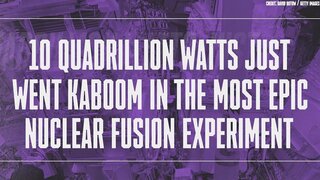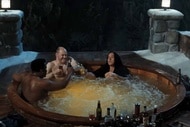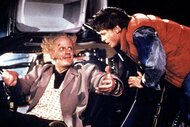Create a free profile to get unlimited access to exclusive videos, sweepstakes, and more!
1.21 gigawatts? 10 quadrillion watts just went kaboom in the most epic nuclear fusion experiment ever

Doc Brown might have exclaimed “1.21 gigawatts!” as if his time machine of a DeLorean was the most powerful thing on Earth, but something has beat that by a long shot.
No matter how excited Christopher Lloyd’s eccentric scientist was in Back to the Future, 1.21 gigawatts (which probably sounded futuristic when the movie came out in 1989) is only a little over a billion watts. How can you say only a billion watts? You can when an experiment that researchers recently pulled off at the Lawrence Livermore National Laboratory’s (LLNL) National Ignition Facility in California generated 10 quadrillion.
Maybe it can’t fly you through time, but a laser blast that intense, even if only for trillionths of a second, has gotten us that much closer to achieving ignition—meaning enough power to make nuclear fusion happen on its own. LLNL’s Team Lead for Stagnation Science, Arthur Kazdan Pak, was at the head of this groundbreaking experiment.
“The fusion power is the amount of fusion energy created divided by the time duration over which the energy is produced, which in this experiment was 100 trillionths of a second,” Kazdan Pak told SYFY WIRE. “So essentially enormous powers can be produced by releasing all the energy over an incredibly short amount of time.”
Nuclear fusion is the same process that stars use to burn hydrogen into helium. Just the fusion of atoms alone creates unbelievable amounts of energy. Your typical chemical combustion reaction has nothing on this. Fusing the nuclei of two hydrogen atoms, which have one proton each, creates helium. It happens in supernovas when giant stars burn out and explode after running out of hydrogen. The immense amount of energy from the explosion fuses atomic nuclei together, which explains why these phenomena leave heavy elements in their wake.
Kazdan Pak and his research team irradiate a metal tube or hohlraum, whose walls balance out the energy flowing through it, with a laser that easily covered the length of three football fields. Its target was a capsule the size of a BB—but wait. There was some thermonuclear fuel made of deuterium and tritium in that target. The laser was able to drive enough radiation to compress and heat the target, which furiously set off one fusion reaction after another. The 10 quadrillion watts of energy that resulted almost equaled how much laser energy was put into the experiment.
If you can fathom it, this improved on results from just months ago by a staggering 8 times. It was the accumulation of small tweaks that made such a difference.
“Improvements to the target increased the amplitude and duration of the radiation drive, which led to a higher initial rate of fusion reactions,” said Kazdan Pak. “This rate of fusion reactions is critical because part of the energy released in each fusion reaction goes on to further heat the reacting plasma.”
Stars are essentially gobs of superheated plasma, so it should be no surprise that a nuclear fusion experiment on Earth involved plasma, but it gets better. Plasma that is heated enough to keep heating itself triggers fusion reactions. This is why an epic succession of fusion reactions went off as the heat went up, eight times more than before. Even heat at these levels has to contend with possible energy loss. Radiation (stars radiate huge amounts of energy in the form of light and heat), conduction and expansion that resulted from flaws in the previous experiment were corrected by redesigning its components.
Preventing energy loss in any form means producing plasma that self-heats at a rate that far exceeds the loss rate—and can sustain that self-heating. Kazdan Pak and his team reduced the diameter of both entrances of the hohlraum, not only so less radiation drive would be lost, but so the amplitude of that drive would get a boost and also so the drive would last longer. Both the capsule shell and capsule fill tube, which is used to fill it with fuel, were also revamped to prevent the plasma becoming unstable.
“Never before have we been able to create a system in which the fusion energy produced is almost equal to the energy supplied in a controlled laboratory setting. The ultimate goal is to produce much more energy than supplied.”
By the way, hohlraums can be the casings for nuclear weapons, which studies like this help develop. We could possibly use one to nuke an asteroid that comes way too close to Earth in the future.















